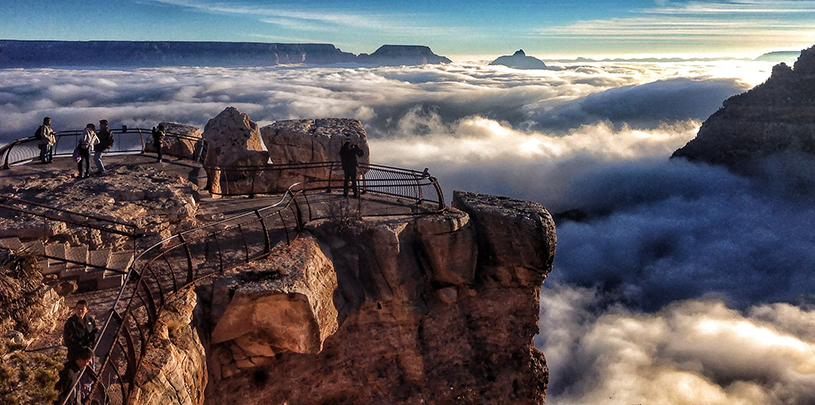
 by Lisa Winters, Communications Manager
by Lisa Winters, Communications Manager
The Grand Canyon tops bucket lists across the world. And if you haven’t experienced the magic and awe of the canyon’s vast views, it’s time for a visit.
Whether you’re planning your trip or already packing your bags, you may be wondering: What is the weather like at the Grand Canyon?
Here’s our advice on the best months to visit Grand Canyon National Park and what to pack for your trip.
 AMY S. MARTIN
AMY S. MARTIN
There’s a good chance you can leave your raincoat at home, but not your windbreaker. Spring is a breezy time in the canyon. Expect melting snow and muddy trails on the rim, which is around 7,000 feet elevation, and an abundance of blooming cactus flowers at lower elevations. Life creeps its way back into the canyon, from the first lizards out sunning on rocks to massive California condors soaring overhead in search of nest sites in the cliffs.
Temperatures on the South Rim warm up from an average high of 51 degrees in March to 70 by May. Overnight lows remain chilly in the 30s.
 M. QUINN, NATIONAL PARK SERVICE
M. QUINN, NATIONAL PARK SERVICE
Kids are out of school for the summer, and it’s time for a family vacation!
Late spring and early summer are the driest times of the year here in the canyon. Expect to see cloudless blue skies and wildlife like elk, mule deer, and bighorn sheep out searching for water.
By July, monsoon storms reliably roll through northern Arizona in the late afternoons, bringing the potential for short but strong thunderstorms into September. Temperatures are pleasant on the rim during the summer months, with average highs in the 80s and lows in the 50s.
But wait. Isn’t the Grand Canyon supposed to be hot?
The farther you descend into the canyon, the hotter it gets. Grand Canyon National Park says that temperatures increase about 5.5 degrees with each 1,000 feet you drop in elevation. So, you may start a hike in the early morning at the rim in a down jacket and strip down to shorts and a tank top by the time you drop more than 4,000 feet to the Colorado River. The temperature regularly tops 100 at Phantom Ranch in the heat of summer.
A good rule of thumb: Temperatures on the rim are similar to Flagstaff, Arizona, while temperatures at the bottom of the Grand Canyon are similar to Phoenix, Arizona.
Know what to pack for your trip ›
 ED MOSS
ED MOSS
The North Rim is set ablaze with swaths of golden heart-shaped aspen leaves fluttering in the breeze in early fall. As temperatures drop, the leaf-peeping moves down into the canyon. Havasupai Gardens, located about 3,000 vertical feet below the South Rim, contains an oasis of large cottonwood trees. By November, the shady respite is a canopy of fiery orange.
Venturing to the Grand Canyon late in the year can be a rewarding experience if you miss the occasional early season snowstorm. Temperatures still reach the 60s in October and 50s in November but drop below freezing at night. Remember to bring a warm jacket and a camera.
Visitors to the Grand Canyon on November 29, 2013 witnessed a rare total inversion (as you see in the photo at the top of this blog, taken at Mather Point on the South Rim). Cloud inversions are formed when warm and cold air masses interact and this one filled the entire canyon with clouds.
Experience the Grand Canyon on foot ›
 M. QUINN, NATIONAL PARK SERVICE
M. QUINN, NATIONAL PARK SERVICE
Imagine hard-packed icy trails, scenic viewpoints to yourself, and a blanket of snow that envelops the canyon in peaceful quiet. The crowds at the South Rim thin out remarkably in December, January, and February. Bring your winter layers and a good pair of crampons — traction for your shoes — if you’re planning on hiking, and you can “weather” the conditions just like the canyon itself.
You can do the same things in the winter as you can in the summer months while soaking in that legendary Arizona sunshine. Average temperatures at the South Rim range from highs in the 40s and drop to the teens at night.
The North Rim sits at a higher elevation — over 8,000 feet — and closes for the winter, typically from mid-October until mid-May, because of snowfall.
Winter guide to the Grand Canyon ›
Bottom line: Pack your layers. The warmest temperatures are felt at the lowest elevations inside the canyon, and clear Southwest skies mean day and night temperatures can swing 30 degrees or more.
And remember: No matter the season, a Grand Canyon sunset does not disappoint.
Don't let a little snow keep you from visiting the Grand Canyon. Here's everything you need to know for a winter trip to the big ditch.
Read MoreFind out where to camp beneath the stars in and around Grand Canyon National Park.
Read MoreSettle in to see one of the most awe-inspiring landscapes in the world transform under an expansive, colorful sky.
Read More